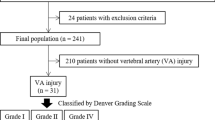Abstract
The incidence of ischemic stroke reported after blunt vertebral artery injury is lower than that reported after blunt carotid artery injury. Unlike the carotid arteries, the vertebral arteries receive collateral blood flow through ascending cervical branches in addition to a convergent arterial supply with the contralateral vertebral artery. We hypothesize that the incidence of stroke after vertebral artery injury is less than after carotid artery injury in part because of reconstitution of vertebral arteries by cervical collaterals. A retrospective blinded interpretation of angiographic studies in 46 patients with blunt vertebral injury was performed to assess for presence and grade of vertebral artery injury and for the presence of reconstitution of the vessel via cervical collaterals. Follow-up CT scans from the same patients were evaluated for the presence of posterior circulation strokes. There were 55 injured vertebral arteries in the 46 patients, of whom 8 experienced posterior fossa strokes. Two-tailed Fisher exact probability test evaluating the hypothesis that patients with vertebral artery collaterals were less likely to experience posterior fossa strokes reached significance, p < 0.05. Of patients with occlusive (grades IV and V) injuries, those with collateral vessels were significantly less likely to experience posterior fossa strokes (p < 0.01). This result may be considered when weighing the potential risks and benefits of antiplatelet or anticoagulation therapy in patients with occlusive blunt vertebral artery injury.



Similar content being viewed by others
References
Biffl WL, Moore EE, Elliott JP, Ray C, Offner PJ, Franciose RJ, Brega KE, Burch JM (2000) The devastating potential of blunt vertebral arterial injuries. Ann Surg 231(5):672–681
Wei CW, Montanera W, Selchen D, Lian J, Stevens C, de Tilly LN (2010) Blunt cerebrovascular injuries: diagnosis and management outcomes. Can J Neurol Sci 37(5):574–579
Biffl WL, Moore EE, Offner PJ, Brega KE, Franciose RJ, Burch JM (1999) Blunt carotid arterial injuries: implications of a new grading scale. J Trauma 47(5):845–853
Biffl WL, Ray CE Jr, Moore EE, Franciose RJ, Aly S, Heyrosa MG, Johnson JL, Burch JM (2002) Treatment-related outcomes from blunt cerebrovascular injuries: importance of routine follow-up arteriography. Ann Surg 235(5):699–706, discussion 706–697
Bub LD, Hollingworth W, Jarvik JG, Hallam DK (2005) Screening for blunt cerebrovascular injury: evaluating the accuracy of multidetector computed tomographic angiography. J Trauma 59(3):691–697
Miller PR, Fabian TC, Bee TK, Timmons S, Chamsuddin A, Finkle R, Croce MA (2001) Blunt cerebrovascular injuries: diagnosis and treatment. J Trauma 51(2):279–285, discussion 285–276
Berne JD, Norwood SH (2009) Blunt vertebral artery injuries in the era of computed tomographic angiographic screening: incidence and outcomes from 8,292 patients. J Trauma 67(6):1333–1338. doi:10.1097/TA.0b013e31818888c7
Berne JD, Cook A, Rowe SA, Norwood SH (2010) A multivariate logistic regression analysis of risk factors for blunt cerebrovascular injury. J Vasc Surg 51(1):57–64. doi:10.1016/j.jvs.2009.08.071
Stein DM, Boswell S, Sliker CW, Lui FY, Scalea TM (2009) Blunt cerebrovascular injuries: does treatment always matter? J Trauma 66(1):132–143. doi:10.1097/TA.0b013e318142d146, discussion 143–134
Spaniolas K, Velmahos GC, Alam HB, de Moya M, Tabbara M, Sailhamer E (2008) Does improved detection of blunt vertebral artery injuries lead to improved outcomes? Analysis of the National Trauma Data Bank. World J Surg 32(10):2190–2194. doi:10.1007/s00268-008-9687-5
Cothren CC, Biffl WL, Moore EE, Kashuk JL, Johnson JL (2009) Treatment for blunt cerebrovascular injuries: equivalence of anticoagulation and antiplatelet agents. Arch Surg 144(7):685–690. doi:10.1001/archsurg.2009.111
Fusco MR, Harrigan MR (2010) Cerebrovascular dissections: a review part II: blunt cerebrovascular injury. Neurosurgery. doi:10.1227/NEU.0b013e3181fe2fda
Zhang H, Prabhakar P, Sealock R, Faber JE (2010) Wide genetic variation in the native pial collateral circulation is a major determinant of variation in severity of stroke. J Cereb Blood Flow Metab 30(5):923–934. doi:10.1038/jcbfm.2010.10
Biffl WL, Cothren CC, Moore EE, Kozar R, Cocanour C, Davis JW, McIntyre RC Jr, West MA, Moore FA (2009) Western Trauma Association critical decisions in trauma: screening for and treatment of blunt cerebrovascular injuries. J Trauma 67(6):1150–1153. doi:10.1097/TA.0b013e3181c1c1d6
Bromberg WJ, Collier BC, Diebel LN, Dwyer KM, Holevar MR, Jacobs DG, Kurek SJ, Schreiber MA, Shapiro ML, Vogel TR (2010) Blunt cerebrovascular injury practice management guidelines: the Eastern Association for the Surgery of Trauma. J Trauma 68(2):471–477. doi:10.1097/TA.0b013e3181cb43da
Franz RW, Goodwin RB, Beery PR 2nd, Hari JK, Hartman JF, Wright ML (2010) Postdischarge outcomes of blunt cerebrovascular injuries. Vasc Endovascular Surg 44(3):198–211. doi:10.1177/1538574409359429
Eastman AL, Muraliraj V, Sperry JL, Minei JP (2009) CTA-based screening reduces time to diagnosis and stroke rate in blunt cervical vascular injury. J Trauma 67(3):551–556. doi:10.1097/TA.0b013e3181b84408, discussion 555–556
Miller PR, Fabian TC, Croce MA, Cagiannos C, Williams JS, Vang M, Qaisi WG, Felker RE, Timmons SD (2002) Prospective screening for blunt cerebrovascular injuries: analysis of diagnostic modalities and outcomes. Ann Surg 236(3):386–393. doi:10.1097/01.SLA.0000027174.01008.A0, discussion 393–385
Author information
Authors and Affiliations
Corresponding author
Rights and permissions
About this article
Cite this article
Fink, K.R., Fink, J.R. & Cohen, W.A. Cervical collaterals may protect against stroke after blunt vertebral artery injury. Emerg Radiol 18, 545–549 (2011). https://doi.org/10.1007/s10140-011-0981-4
Received:
Accepted:
Published:
Issue Date:
DOI: https://doi.org/10.1007/s10140-011-0981-4




